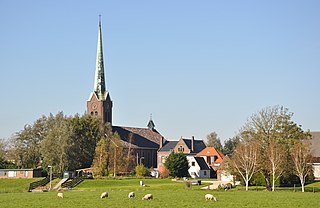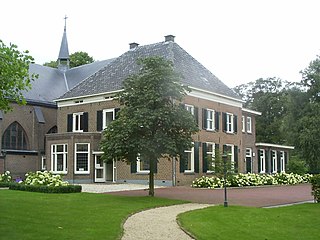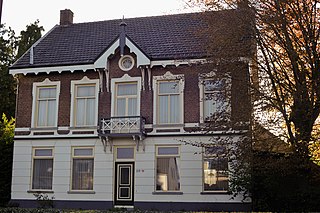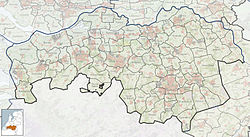
Kapelle is a municipality and a town in the southwestern Netherlands on Zuid-Beveland. In 2023 the municipality's population amounts to 13,051.

Bergen op Zoom is a city and municipality in southwestern Netherlands. It is located in the province of North Brabant, at the provincial border with Zeeland. In January 2021, the municipality had a population of 67,514.

Rucphen is a municipality and a town in the southern Netherlands between Roosendaal and Etten-Leur, south of the railway, but without a train-station.

Heiloo is a municipality and town in the Netherlands, located in the province of North Holland. The community is part of the cooperation region Kennemerland and is located in the historical region of West Friesland. Heiloo had a population of 24,144 in 2021.

Sprundel is a village in the southern Netherlands, in the Rucphen municipality. In the past it was the main village of the region, with roads to Roosendaal to the west, Breda to the east, Rotterdam to the north and Antwerp to the south.

Aldtsjerk is a village on the main road from Leeuwarden to Dokkum. It is part of Tytsjerksteradiel municipality, Friesland, the Netherlands and had around 615 inhabitants as of January 2018.

Sint Willebrord is a town in the municipality of Rucphen in the Netherlands. It is also known by the name 't Heike which was the semi-official name up until 1950/1970, which is the diminutive form of hei (heath) in local dialect. This town was formed on the former boundary between the "Baronie of Breda" and "Het Markizaat of Bergen op Zoom". Sint Willebrord is the largest of the five towns in the municipality of Rucphen. During Carnaval the town goes by the name of Heikneutersland Basically meaning ´Hillbillies´ land´ or ´Redneck's land´. The name "Sint Willebrord" comes from Saint Willibrord. Sint is the usual form in Dutch names to represent saints. Cyclist Wim van Est and footballer Rini (Pallack) Konings were famous sports personalities from Sint Willebrord.

Breda is a city and municipality in the southern part of the Netherlands, located in the province of North Brabant. The name derived from brede Aa and refers to the confluence of the rivers Mark and Aa. Breda has 185,072 inhabitants on 13 September 2022 and is part of the Brabantse Stedenrij; it is the ninth largest city/municipality in the country, and the third largest in North Brabant after Eindhoven and Tilburg. It is equidistant from Rotterdam and Antwerp.

Hoogmade is a village in the Dutch province of South Holland. It is located about 7 km east of Leiden, in the municipality of Kaag en Braassem.

Beltrum is a village in the region called Achterhoek in the province of Gelderland in the Netherlands.

Kapellebrug is a village in the Dutch province of Zeeland. It is a part of the municipality of Hulst, and lies about 31 km southwest of Bergen op Zoom.

Wouw is a village in the southern Netherlands. It is located in North Brabant, between the cities Roosendaal and Bergen op Zoom, close to the border with Belgium.

Ohé en Laak is a village in the province of Limburg, Netherlands, which has been subsumed into the municipality of Maasgouw. The village used to be home to several castles, one of which is Hasseltholt which is popularly called "Het Geudje". The other was the castle of Walburg. This castle was ruined and is fully removed now. The soccer team is called Walburgia. Furthermore, there is a renovated windmill called "De Hompesche molen". In the past this windmill was used for milling wheat and corn flour. The village of Ohé en Laak has got a nice yacht harbour at the river Maas and currently there are three campsites. The majority of the inhabitants are Roman Catholics, there is a church called "Onze Lieve Vrouw Geboorte" and a chapel called "Sint Anna-kapel".

Bergharen is a village in the Netherlands, in the municipality of Wijchen. It was a separate municipality until 1984. There is a windmill, De Verrekijker, which has been converted to a holiday cottage.
Velp is a Dutch village located east of Arnhem within the municipality of Rheden, between Arnhem, Rozendaal, and the town of Rheden.

Westmaas is a village in the Dutch province of South Holland. It is located about 14 km south of the city of Rotterdam, next to Mijnsheerenland in the municipality of Hoeksche Waard. In 2020, the population was 2,065.

Heerle is a village in the municipality of Roosendaal, in the Dutch province of North Brabant. Before the municipal reorganisation of 1997, Heerle was part of the municipality of Wouw. It lies between the cities of Bergen op Zoom and Roosendaal.

Bosschenhoofd is a village in the municipality of Halderberge in the province of North Brabant in the Netherlands. The village is also known as Seppe, a name used by the nearby Seppe Airport. Seppe was derived from Jacobus Sep who ran an inn. Before the municipal reorganization of 1997, Bosschenhoofd belonged to the municipality of Hoeven.

Biezelinge is a neighbourhood of Kapelle and former village in the Dutch municipality of Kapelle.

Schilberg is a neighborhood in the Dutch Limburgish village of Echt. It is home to Our Lady of Schilberg, a chapel and pilgrimage site. It was home to 1,870 people in 2021.

























